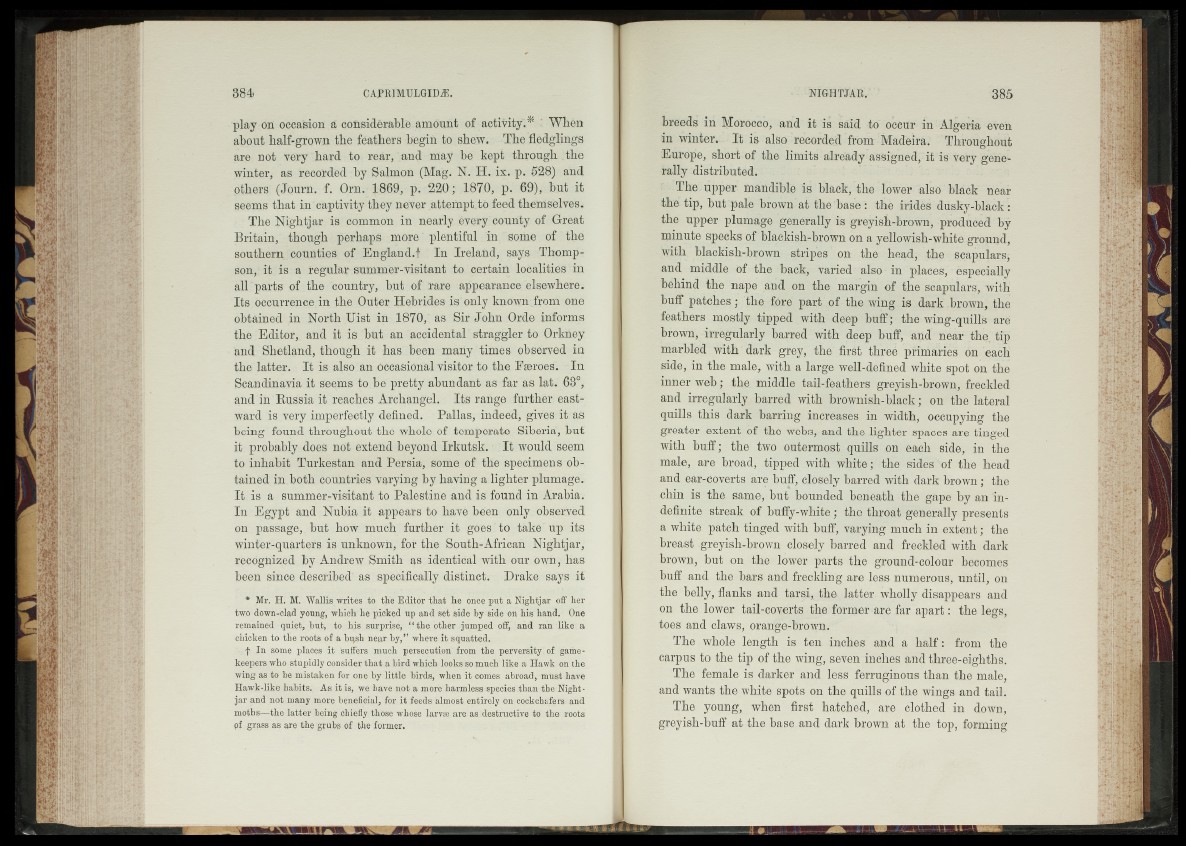
play on occasion considerable amount of activity.* When
about half-grown the feathers begin to shew. The fledglings
are not very hard to rear, and may be kept through the
winter, as recorded by Salmon (Mag. N. H. ix. p. 528) and
others (Journ. f. Orn. J869, p, 220; 1870, p. 69), but it
seems that in'captivity they never attempt, to feed themselves.
The Nightjar is common in nearly évery county of Great
Britain, though perhaps more ’ plentiful in some of the
southern counties of England.! In Ireland, says Thompson,
it is a regular summer-visitant to certain localities in
all parts of the country, but of rare appearance elsewhere.
Its occurrence in the Outer Hebrides is only known from one
obtained in North Uist in 1870, as Sir John Orde informs
the Editor, and it is but an accidental straggler to Orkney
and Shetland, though it has been many times observed in
the latter. It is also an occasional visitor to the Faeroes. In
Scandinavia it seems to be pretty abundant as far as lat. 63°,
and in Russia it reaches Archangel. Its range further eastward
is very imperfectly defined. Pallas, indeed, gives it as
being found throughout the whole of temperate Siberia, but
it probably does not extend beyond Irkutsk. It would seem
to inhabit Turkestan and Persia, some of the specimens obtained
in both countries varying by having a lighter plumage.
It is a summer-visitant to Palestine and is found in Arabia.
In Egypt and Nubia it appears to have been only observed
on passage, but how much further it goes to take up its
winter-quarters is unknown, for the South-African Nightjar,
recognized by Andrew Smith as identical with our own, has
been since described as specifically distinct. Drake says it
* Mr. H. M. Wallis writes to the Editor that he once put a Nightjar off her
two down-clad young, which he picked up and set side by side on his hand. One
remained quiet, hut, to his surprise, “ the other jumped off, and ran like a
chicken to the roots of a bqsh near by,” where it squatted.
f In some places it suffers much persecution from the perversity of game-
keepers who stupidly consider that a bird which looks so much like a Hawk on the
wing as to be mistaken for one by little birds, when it comes abroad, must have
Hawk-like habits. As it is, we have not a more harmless species than the Nightjar
and not many more beneficial, for it feeds almost entirely on cockchafers and
moths—the latter being chiefly those whose larvae are as destructive to the roots
pf grass as are the grubs óf the former.
breeds in Morocco, and it is said to occur in Algeria even
in winter. It is also recorded from Madeira. Throughout
Europe, short of the limits already assigned, it is very generally
distributed.
The. upper mandible is black, the lower also black near
the tip, but pale brown at the base : the irides dusky-black:
the upper plumage generally is greyish-brown, produced by
minute specks of blackish-brown on a yellowish-white ground,
with blackish-brown stripes on the head, the scapulars;
and middle of the back, varied also in places, especially
behind the nape and on the margin of the scapulars, with
buff patches; the fore part of the wing is dark brown, the
feathers mostly tipped with deep buff ; the wing-quills are
brown, irregularly barred with deep buff, and near the. tip
marbled with dark grey, the first three primaries on each
side, in the male, with a large well-defined white spot on the
inner web; the middle tail-feathers greyish-brown, freckled
and irregularly barred with brownish-black; on the lateral
quills this dark barring increases in width, occupying the
greater extent of the webs, and the lighter spaces are tinged
with buff; the two outermost quills on each side, in the
male, are broad, tipped with white; the sides of the head
and ear-coverts are buff, closely barred with dark brown ; the
chin is the same, but bounded beneath the gape by an indefinite
streak of buffy-white; the throat generally presents
a white patch tinged with buff, varying much in extent; the
breast greyish-brown closely barred and freckled with dark
brown, but on the lower parts the ground-colour becomes
buff and the bars and freckling are less numerous, until, on
the belly, flanks and tarsi, the latter wholly disappears and
on the lower tail-coverts the former are far apart: the legs,
toes and claws, orange-brown.
The whole length is ten inches and a h a lf: from the
carpus to the tip of the wing, seven inches and three-eighths.
The female is darker and less ferruginous than the male,
and wants the white spots on the quills of the wings and tail.
The young, when first hatched, are clothed in down,
greyish-buff at the base and dark brown at the top, forming